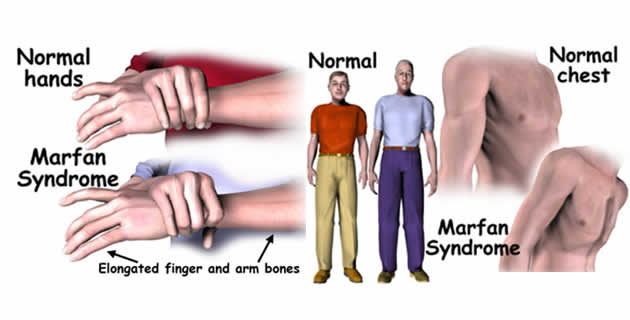
Marfan syndrome is an inherited connective tissue disorder that affects normal body growth. Connective tissue provides support for the skeletal structure and all the organs of the body.
Any disorder that affects the connective tissue, such as Marfan syndrome, can affect the entire body, including the organs, skeletal system, skin, eyes, and heart.
One of the biggest threats of Marfan syndrome is damage to the aorta, the artery that carries blood from the heart to the rest of the body. Marfan syndrome can rupture the inner layers of the aorta, causing dissection that leads to bleeding in the wall of the vessel.
Aorta dissection can be deadly. Surgery may be required to replace the affected part of the aorta.
Symptoms
The signs and symptoms of Marfan syndrome vary greatly, even among members of the same family. Some people experience only mild effects, but others develop life-threatening complications. In most cases, the disease tends to worsen with age.
Marfan syndrome features may include;
- Tall and slender build
- Disproportionately long arms, legs and fingers
- A breastbone that protrudes outward or dips inward
- A high, arched palate and crowded teeth
- Heart murmurs
- Extreme nearsightedness
- An abnormally curved spine
- Flat feet
Causes of Marfan Syndrome
Marfan syndrome is a genetic or inherited disorder. The genetic defect occurs in a protein called fibrillin-1, which plays a large role in the formation of the connective tissue. The defect also causes overgrowth in bones, resulting in long limbs and significant height.
There’s a 50 percent chance that if one parent has this disorder, their child will also have it (autosomal dominant transmission).
However, a spontaneous genetic defect in their sperm or egg can also cause a parent without Marfan syndrome to have a child with this disorder.
Diagnosis
Marfan syndrome is based on a clinical diagnosis. A multidisciplinary approach is necessary to make the diagnosis because multiple organ systems must be assessed. Members of the team will assess the eyes, heart and blood vessels, spine and skeletal system.
A thorough history of symptoms and information about family members that may have had related problems are also necessary.
Other tests, such as chest x-ray, electrocardiogram (ECG) and echocardiogram (an imaging procedure that uses high frequency sound waves to produce a moving picture of the heart’s valves and chambers) will be used to evaluate changes in the heart and blood vessels, and detect heart rhythm problems.
Treatments
Marfan syndrome requires a treatment plan that is individualized to the patient’s needs. Some people need regular follow-up appointments with the doctor, and during growth years, routine cardiovascular, eye, and orthopedic exams.
Others may need medications or surgery. The approach depends on the structures affected and the severity.
What We Offer
We at Almurshidi Medical Tourism will find the best doctors to cater to your needs. We are partnered with a wide network of hospitals and clinics that provide top quality medical experience.
We provide free medical estimates, make medical appointments, and provide several medical opinions if needed at no cost.
Contact Us
For more information contact us at +66822004040 or via WhatsApp





